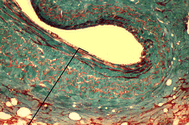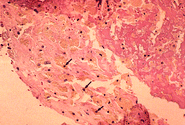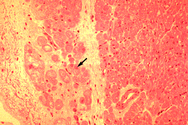 Identify the structure within the bracket:
Identify the structure within the bracket:
Question 1 - Single Best Answer
 Identify the structure within the bracket:
Identify the structure within the bracket:
A) muscular artery
B) large vein
C) venule
D) elastic artery
E) lymphatic vessel
Question 2 - Single Best Answer
 Identify the cell at the tip of the arrow:
Identify the cell at the tip of the arrow:
A) fibroblast
B) dust cell
C) foam cell
D) mast cell
E) adipocyte
Question 3 - Single Best Answer
A) pulmonary artery
B) bronchiole
C) muscular artery
D) pulmonary vein
E) bronchus
Question 4 - Single Best Answer
A) adipocyte
B) venule
C) lymphatic vessel
D) arteriole
E) capillary
Question 5 - Single Best Answer
A) lymphatic vessel
B) venule
C) large vein
D) elastic artery
E) muscular artery
Question 6 - Single Best Answer
 Identify the cell at the tip of the arrow:
Identify the cell at the tip of the arrow:
A) smooth muscle cell
B) cardiac muscle cell
C) fibroblast
D) purkinje fiber
E) adipocyte
Question 7 - Single Best Answer
A) large vein
B) venule
C) arteriole
D) lymphatic vessel
E) capillary
Question 8 - Single Best Answer
 Identify the layer of the blood vessel:
Identify the layer of the blood vessel:
A) tunica adventitia
B) tunica media
C) tunica intima
Question 9 - Single Best Answer
A) bronchiole
B) pulmonary vein
C) bronchus
D) pulmonary artery
E) muscular artery
Question 10 - Single Best Answer
A) lymphatic vessel
B) capillary
C) arteriole
D) adipocyte
E) venule
Question 11 - Single Best Answer
An 85 year old black male presents for an annual exam. On auscultation of his heart, no abnormalities are found. However, a carotid bruit(sound indicating turbulence or loud blood flow at the carotid artery) is heard bilaterally. This is usually associated with atherosclerosis(hardening of the arteries). The remainder of the exam is normal. What is the most immediately worrisome complication associated with these findings? OK THIS IS A DIFFICULT QUESTION BUT YOU'LL BE AHEAD OF THE GAME 2ND YR IF YOU REMEMBER IT!
A) There are no risks associated with these findings.
B) lung cancer
C) Death secondary to cardiovascular damage to vital organs such as the brain and heart.
D) high blood pressure
Question 12 - Single Best Answer
What is the mechanism of the problem?
A) severe lack of red blood cells(severe anemia)
B) damage to the tunica intima
C) abnormal anatomy of the vessels
D) inaccurate examination technique
Question 13 - Single Best Answer
What cell would migrate to the lesion in order to "clean up the mess"?
A) smooth muscle cell
B) dust cell
C) macrophage
D) kupffer cell
Question 14 - Single Best Answer
Choose the term that is defined as a lesion occuring secondary to ischemia(lack or low amount of oxygen).
A) infarct
B) dysplasia
C) anemia
D) metaplasia
Question 15 - Single Best Answer
A patient comes in to the ER with a complaint of back pain that "throbs". His blood pressure is rapidly decreasing(a bad sign) and his pulse is rapidly increasing in order to maintain blood circulation. This occurs when the aortic wall separates and blood fills the new space rather than move distally to the tissues. Also, the cardiovascular system detects this as acute blood loss so the pulse increases. This process is known as aortic dissection. Find the photo of a normal aorta.
A)
B)
C)
D)
Question 16 - Single Best Answer
What type of vessel is the aorta?
A) lymphatic
B) elastic
C) muscular
D) large vein